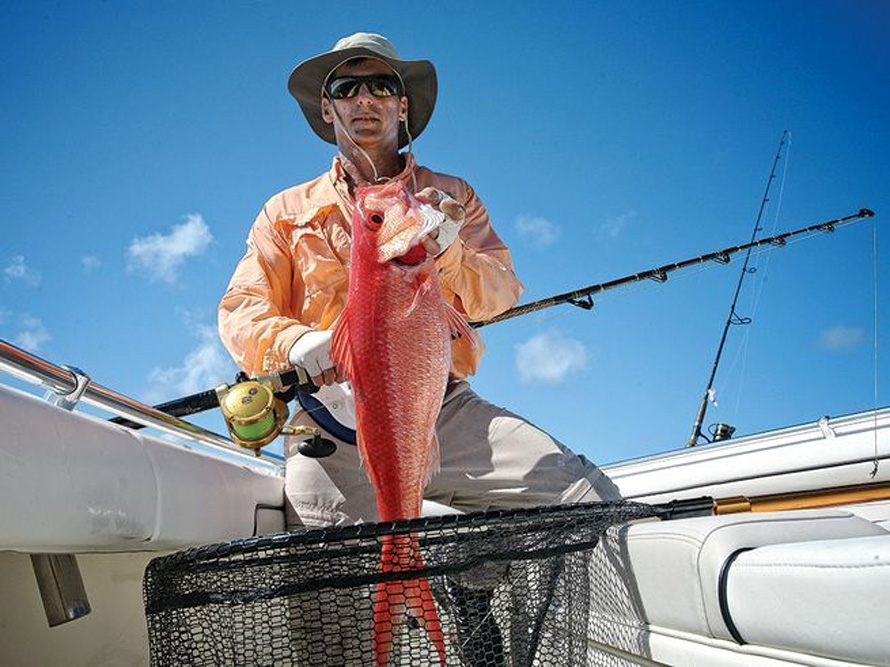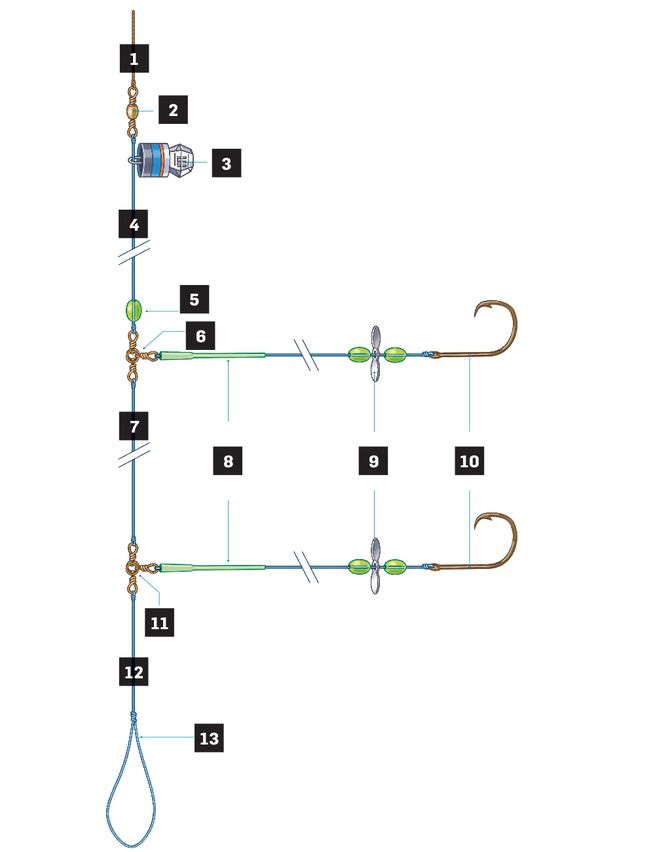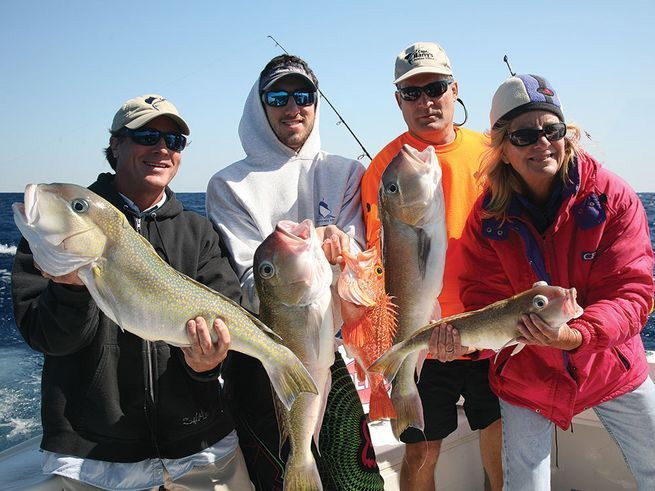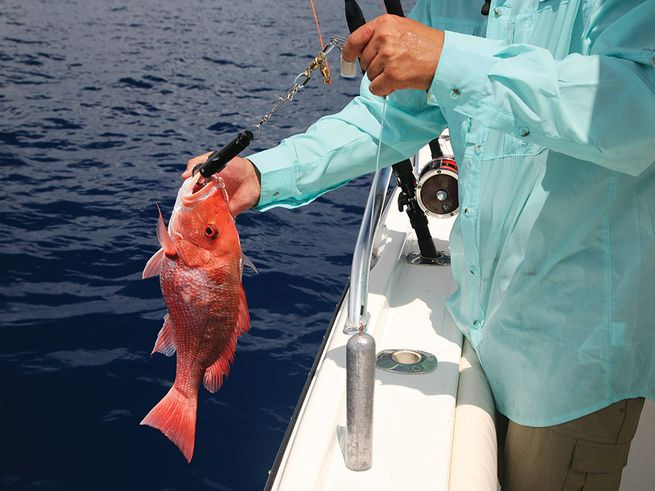|
Deep-Dropping Strategies to Make Fishing More Fun
|
| Hand cranking makes deep-dropping tactics more sporty and rewarding |
| by George Poveromo |
 |
Fishing for benthic-zone dwellers continues to blossom in popularity. But an increasing number of anglers are departing from traditional deep-dropping and pulling those big bottomfish up from the depths with the push of a button. Where’s the sport in that? There are, of course, situations for which the use of electric reels makes perfect sense. For instance, when the angler is physically unable to use conventional tackle. But in my humble opinion, deep-dropping is more fun and rewarding when those prize trophies are hand-cranked the good old-fashioned way. Deep-Dropping Rigging Tips  |
|
| Deep-dropping for bottomfish occurs from around 400 feet on out to the edges of underwater canyons, pinnacles and other specific bottom formations in depths approaching and often exceeding 1,000 feet. Trumping the assorted smaller denizens and deepwater sharks lurking near the bottom are prize blueline and golden tilefish, barrelfish, queen snapper, snowy grouper and wreckfish, all delicious table fare. Thoughts of laboriously winding up heavy fish from extreme depths lead many anglers to steer clear of the hand-cranking option. Yet that may be just a case of fearing fear itself, because deep-dropping is predicated on fishing in calm seas and a slow to moderate current. And while weights up to 5 pounds are required on occasion, 16 to 48 ounces cover most applications, and retrieving a bait with that kind of weight is not difficult with the proper tackle. Fighting a hooked fish does take some elbow grease, but the pace is usually a relaxed one. There’s none of the muscling up fish in fast order, as required with big groupers, amberjack and snappers on traditional reefs and wrecks. And near the halfway point, barotrauma (rapid decompression) assists the angler by floating the fish up to the surface. From a conservation standpoint, given the strict bag limits on some of the mentioned deepwater species, you’re targeting a single specimen or two, not multiples. Once a limit is reached, you move on to something else. There’s little discard when rules force you to release fish. |
 |
Common deep-dropping catches include golden tilefish and blackbelly rosefish |
| Proper Tackle Modern tackle has simplified hand-crank, deep-drop tactics. For example, small to midsize conventional two-speed reels capable of holding 500 to 600 yards of braided line are perfect for the task. Their compact sizes and light weights keep fatigue to a minimum. For the drops we occasionally do, I opt for Penn Torque 30 and 40 two-speed, lever-drag reels, which hold over 600 and nearly 800 yards of 50-pound braid, respectively. That much line capacity may seem like overkill, but even 600 feet down, it affords a larger spool diameter to pick up more line with every turn of the handle. A high gear ratio brings a bait up faster, whereas a low ratio provides the torque to keep big fish coming up. A 5½- to 6-foot rod rated for 50- to 100-pound line is plenty stout to accommodate the weights required to reach bottom and overpower large, deepwater dwellers. Again, these outfits are comfortable enough to hold and to fight fish with. There’s always the rod holder to accommodate the outfit while cranking up a bait to check it or when fighting a fish. Swivel rod holders are perfect for this because they’re designed to keep the rod aimed toward the fish. |
End Games Dr. Ken Neill III is an accomplished hand-crank, deep-drop pro in his home waters of Virginia. Adhering to IGFA rules, Neill has set 12 all-tackle world records on species ranging from blueline tilefish to snowy grouper weighing over 70 pounds. He has this fishery dialed in, and to keep within IGFA standards, Neill uses either a single- or dual-hook dropper rig comprised of 60- to 100-pound mono. Hook size is commonly 8/0 yet adjusted based on the size of fish. Neill attaches a small strobe light near the top of the rig and glow beads off each hook. To produce vibrations, he favors a spinner blade between glow beads in front of the hook. A quick-change sinker rides at the bottom of the setup. Neill uses both circle and J-style hooks. When fish are not aggressive, the quick set of a J-hook outperforms waiting with a circle hook . He prefers 65-pound braid, which makes it easy to fish J-hooks (regulations may require the circle hooks exclusively). Both hook styles catch fish equally well. |
|
"Sometimes it’s a matter of probing different sections of a given area to uncover fish. That’s often the case with golden tilefish, which tend to colonize within certain zones along a stretch of muddy bottom." |
 |
Deep-Water SeaQualizer Catch-and-release is not usually practiced when deep-dropping. However, there are instances when fish must be released due to species-specific season closures, or size and creel limits. The Deep Water SeaQualizer is a convenient and effective device to release deepwater fish with excellent chances of survival. It requires the use of a conventional outfit with 80-pound braid. The end of the braid is secured to one eye of a three-way swivel. The SeaQualizer clips onto the second eye, then a 3- to 5-pound weight is affixed to the third eye. You then clip the device onto the jaws of the fish, adjust the pressure setting (for 100, 200 or 300 feet), and slowly lower the fish back to the depths, allowing it to recompress and regain its composure so it swims away when water pressure triggers the release at the desired depth. |

